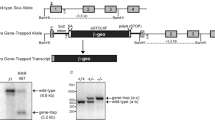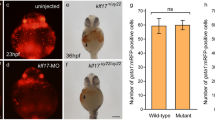Abstract
RhoA small GTPase, as a key regulator for actin cytoskeletal rearrangement, plays pivotal roles during morphogenesis, cytokinesis, phagocytosis and cell migration, but little is known about its signaling mechanism that controls cell survival in vivo. Using zebrafish as a model, we show that non-overlapping antisense morpholinos that block either translation or splicing of rhoA lead to extensive apoptosis during embryogenesis, resulting in overall reduction of body size and body length. These defects are associated with reduced activation of growth-promoting Erk and decreased expression of anti-apoptotic bcl-2. Moreover, ectopic expression of rhoA, Mek or BCL-2 mRNA rescues such phenotypes. Consistently, combined suppression of RhoA and Mek/Erk or Bcl-2 pathways by sub-optimal dose of rhoA morpholino and pharmacological inhibitors for either Mek (U0126) or Bcl-2 (HA 14-1) can induce developmental abnormalities and enhanced apoptosis, similar to those caused by effective RhoA knockdown. Furthermore, U0126 abrogates the rescue by RhoA and MEK but not BCL-2. In contrast, HA 14-1 effectively abolishes all functional rescues by RhoA, MEK or BCL-2, supporting that RhoA prevents apoptosis by activation of Mek/Erk pathway and requiring Bcl-2. These findings reveal an important genetic and functional relationship between RhoA with Mek/Erk and Bcl-2 for cell survival control during embryogenesis.
This is a preview of subscription content, access via your institution
Access options
Subscribe to this journal
Receive 50 print issues and online access
$259.00 per year
only $5.18 per issue
Buy this article
- Purchase on Springer Link
- Instant access to full article PDF
Prices may be subject to local taxes which are calculated during checkout





Similar content being viewed by others
References
Aznar S, Lacal JC . (2001). Rho signals to cell growth and apoptosis. Cancer Lett 165: 1–10.
Beis D, Stainier D . (2006). In vivo cell biology: following the zebrafish trend. Trends Cell Biol 16: 105–112.
Bijian K, Takano T, Papillon J, Le Berre L, Michaud J, Kennedy C et al. (2005). Actin cytoskeleton regulates extracellular matrix-dependent survival signals in glomerular epithelial cells. Am J Physiol Renal Physiol 289: F1313–F1323.
Blanco-Colio L, Villa A, Ortego M, Hernandez-Presa M, Pascual A, Plaza J et al. (2002). 3-Hydroxy-3-methyl-glutaryl coenzyme A reductase inhibitors, atorvastatin and simvastatin, induce apoptosis of vascular smooth muscle cells by downregulation of Bcl-2 expression and Rho A prenylation. Atherosclerosis 161: 17–26.
Cole LK, Ross LS . (2001). Apoptosis in the developing zebrafish embryo. Dev Biol 240: 123–142.
Coleman ML, Sahai EA, Yeo M, Bosch M, Dewar A, Olson MF . (2001). Membrane blebbing during apoptosis results from caspase-mediated activation of ROCK I. Nat Cell Biol 3: 339–345.
Corson L, Yamanaka Y, Lai K, Rossant J . (2003). Spatial and temporal patterns of ERK signaling during mouse embryogenesis. Development 130: 4527–4537.
Del Re DP, Miyamoto S, Brown JH . (2007). RhoA/Rho kinase up-regulate Bax to activate a mitochondrial death pathway and induce cardiomyocyte apoptosis. J Biol Chem 282: 8069–8078.
Deng X, Kornblau S, Ruvolo P, May Jr W . (2001). Regulation of Bcl2 phosphorylation and potential significance for leukemic cell chemoresistance. J Natl Cancer Inst Monogr 2000: 30–37.
Doshi JM, Tian D, Xing C . (2006). Structure-activity relationship studies of ethyl 2-amino-6-bromo-4-(1-cyano-2-ethoxy-2-oxoethyl)-4H-chromene-3-carboxylate (HA 14-1), an antagonist for antiapoptotic Bcl-2 proteins to overcome drug resistance in cancer. J Med Chem 49: 7731–7739.
Etienne-Manneville S, Hall A . (2002). Rho GTPases in cell biology. Nature 420: 629–635.
Fromigue O, Hay E, Modrowski D, Bouvet S, Jacquel A, Auberger P et al. (2006). RhoA GTPase inactivation by statins induces osteosarcoma cell apoptosis by inhibiting p42/p44-MAPKs-Bcl-2 signaling independently of BMP-2 and cell differentiation. Cell Death Differ 13: 1845–1856.
Gabay L, Seger R, Shilo B . (1997). In situ activation pattern of Drosophila EGF receptor pathway during development. Science 277: 1103–1106.
Giehl K . (2005). Oncogenic Ras in tumour progression and metastasis. Biol Chem 386: 193–205.
Gomez J, Martinez C, Giry M, Garcia A, Rebollo A . (1997). Rho prevents apoptosis through Bcl-2 expression: implications for interleukin-2 receptor signal transduction. Eur J Immunol 27: 2793–2799.
Harms C, Bosel J, Lautenschlager M, Harms U, Braun JS, Hortnagl H et al. (2004). Neuronal gelsolin prevents apoptosis by enhancing actin depolymerization. Mol Cell Neurosci 25: 69–82.
Henning S, Galandrini R, Hall A, Cantrell D . (1997). The GTPase Rho has a critical regulatory role in thymus development. EMBO J 16: 2397–2407.
Hong C, Peterson Q, Hong J, Peterson R . (2006). Artery/vein specification is governed by opposing phosphatidylinositol-3 kinase and MAP kinase/ERK signaling. Curr Biol 16: 1366–1372.
Kimmel C, Ballard W, Kimmel S, Ullmann B, Schilling T . (1995). Stages of embryonic development of the zebrafish. Dev Dyn 203: 253–310.
Klemke RL, Cai S, Giannini AL, Gallagher PJ, de Lanerolle P, Cheresh DA . (1997). Regulation of cell motility by mitogen-activated protein kinase. J Cell Biol 137: 481–492.
Kobayashi K, Takahashi M, Matsushita N, Miyazaki J, Koike M, Yaginuma H et al. (2004). Survival of developing motor neurons mediated by Rho GTPase signaling pathway through Rho-kinase. J Neurosci 24: 3480–3488.
Korichneva I, Hammerling U . (1999). F-actin as a functional target for retro-retinoids: a potential role in anhydroretinol-triggered cell death. J Cell Sci 112 (Part 15): 2521–2528.
Krens S, He S, Spaink H, Snaar-Jagalska B . (2006). Characterization and expression patterns of the MAPK family in zebrafish. Gene Expr Patterns 6: 1019–1026.
Langheinrich U, Hennen E, Stott G, Vacun G . (2002). Zebrafish as a model organism for the identification and characterization of drugs and genes affecting p53 signaling. Curr Biol 12: 2023–2028.
Li X, Liu L, Tupper J, Bannerman D, Winn R, Sebti S et al. (2002). Inhibition of protein geranylgeranylation and RhoA/RhoA kinase pathway induces apoptosis in human endothelial cells. J Biol Chem 277: 15309–15316.
Martin SS, Leder P . (2001). Human MCF10A mammary epithelial cells undergo apoptosis following actin depolymerization that is independent of attachment and rescued by Bcl-2. Mol Cell Biol 21: 6529–6536.
McClintock JM, Kheirbek MA, Prince VE . (2002). Knockdown of duplicated zebrafish hoxb1 genes reveals distinct roles in hindbrain patterning and a novel mechanism of duplicate gene retention. Development 129: 2339–2354.
McWhorter ML, Monani UR, Burghes AH, Beattie CE . (2003). Knockdown of the survival motor neuron (Smn) protein in zebrafish causes defects in motor axon outgrowth and pathfinding. J Cell Biol 162: 919–931.
Miyake H, Hara I, Yamanaka K, Gohji K, Arakawa S, Kamidono S . (1999). Overexpression of Bcl-2 enhances metastatic potential of human bladder cancer cells. Br J Cancer 79: 1651–1656.
Navarro P, Valverde A, Benito M, Lorenzo M . (1999). Activated Ha-ras induces apoptosis by association with phosphorylated Bcl-2 in a mitogen-activated protein kinase-independent manner. J Cell Biol 274: 18857–18863.
Pinkas J, Martin SS, Leder P . (2004). Bcl-2-mediated cell survival promotes metastasis of EpH4 betaMEKDD mammary epithelial cells. Mol Cancer Res 2: 551–556.
Posey SC, Bierer BE . (1999). Actin stabilization by jasplakinolide enhances apoptosis induced by cytokine deprivation. J Biol Chem 274: 4259–4265.
Rikitake Y, Kawashima S, Yamashita T, Ueyama T, Ishido S, Hotta H et al. (2000). Lysophosphatidylcholine inhibits endothelial cell migration and proliferation via inhibition of the extracellular signal-regulated kinase pathway. Arterioscler Thromb Vasc Biol 20: 1006–1012.
Rios-Munoz W, Soto I, Duprey-Diaz MV, Blagburn J, Blanco RE . (2005). Fibroblast growth factor 2 applied to the optic nerve after axotomy increases Bcl-2 and decreases Bax in ganglion cells by activating the extracellular signal-regulated kinase signaling pathway. J Neurochem 93: 1422–1433.
Tahinci E, Symes K . (2003). Distinct functions of Rho and Rac are required for convergent extension during Xenopus gastrulation. Dev Biol 259: 318–335.
Wang JL, Liu D, Zhang ZJ, Shan S, Han X, Srinivasula SM et al. (2000). Structure-based discovery of an organic compound that binds Bcl-2 protein and induces apoptosis of tumor cells. Proc Natl Acad Sci USA 97: 7124–7129.
Westerfield M . (2000). The Zebrafish Book. A Guide for The Laboratory Use of Zebrafish (Danio Rerio). University of Oregon Press: Eugene.
Wick W, Wagner S, Kerkau S, Dichgans J, Tonn JC, Weller M . (1998). BCL-2 promotes migration and invasiveness of human glioma cells. FEBS Lett 440: 419–424.
Wullimann M, Knipp S . (2000). Proliferation pattern changes in the zebrafish brain from embryonic through early postembryonic stages. Anat Embryol 202: 385–400.
Yao Y, Li W, Wu J, Germann U, Su M, Kuida K et al. (2003). Extracellular signal-regulated kinase 2 is necessary for mesoderm differentiation. Proc Natl Acad Sci USA 100: 12759–12764.
Zhao M, Discipio R, Wimmer A, Schraufstatter I . (2006). Regulation of CXCR4-mediated nuclear translocation of extracellular signal-related kinases 1 and 2. Mol Pharmacol 69: 66–75.
Zhu S, Liu L, Korzh V, Gong Z, Low BC . (2006). RhoA acts downstream of Wnt5 and Wnt11 to regulate convergence and extension movements by involving effectors Rho kinase and Diaphanous: use of zebrafish as an in vivo model for GTPase signaling. Cell Signal 18: 359–372.
Acknowledgements
This work was supported by a Graduate Research Scholarship awarded to SZ and grant from the Biomedical Research Council of Singapore.
Author information
Authors and Affiliations
Corresponding author
Additional information
Supplementary Information accompanies the paper on the Oncogene website (http://www.nature.com/onc).
Supplementary information
Rights and permissions
About this article
Cite this article
Zhu, S., Korzh, V., Gong, Z. et al. RhoA prevents apoptosis during zebrafish embryogenesis through activation of Mek/Erk pathway. Oncogene 27, 1580–1589 (2008). https://doi.org/10.1038/sj.onc.1210790
Received:
Revised:
Accepted:
Published:
Issue Date:
DOI: https://doi.org/10.1038/sj.onc.1210790
Keywords
This article is cited by
-
Mechanism of RhoA regulating benign prostatic hyperplasia: RhoA-ROCK-β-catenin signaling axis and static & dynamic dual roles
Molecular Medicine (2023)
-
Pseudomonas aeruginosa ExoS Induces Intrinsic Apoptosis in Target Host Cells in a Manner That is Dependent on its GAP Domain Activity
Scientific Reports (2018)
-
Crosstalk of Ras and Rho: activation of RhoA abates Kras-induced liver tumorigenesis in transgenic zebrafish models
Oncogene (2014)
-
Contributions of the RhoGEF activity of p210 BCR/ABL to disease progression
Leukemia (2013)



